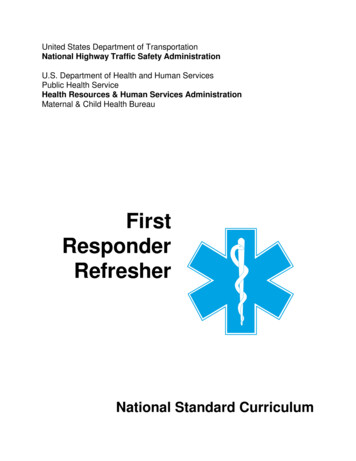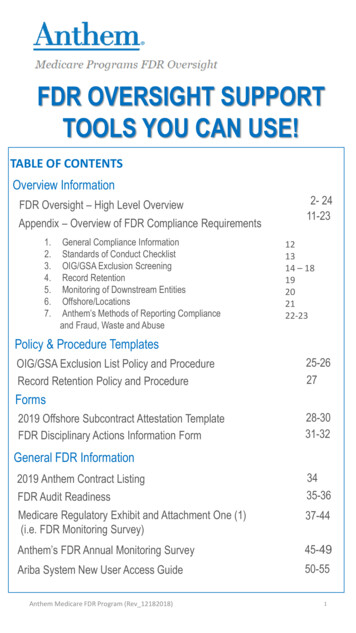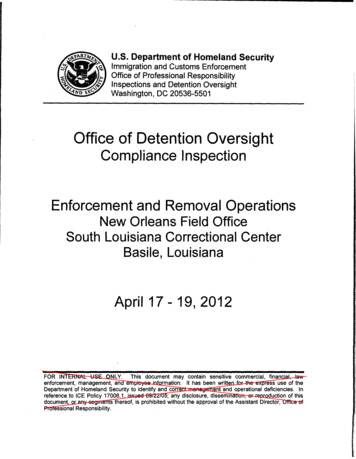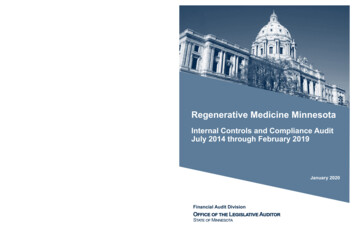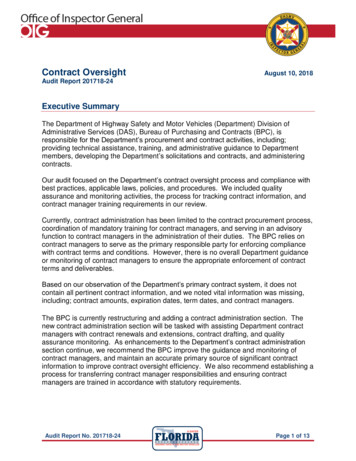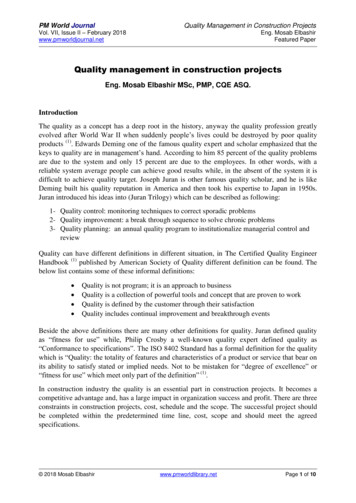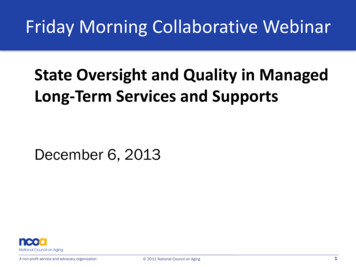
Transcription
Friday Morning Collaborative WebinarState Oversight and Quality in ManagedLong-Term Services and SupportsDecember 6, 2013A non-profit service and advocacy organization 2011 National Council on Aging1
Friday Morning Collaborative Leading AgeLutheran Services in AmericaNational Association of Area Agencies on AgingNational Association of Council on DevelopmentalDisabilities National Association for Home Care and Hospice National Committee to Preserve Social Security andMedicare National Council on Aging National Council on Independent Living National Consumer Voice for Quality Long-Term Care National Disability Rights Network National Domestic Workers Alliance and CaringAcross Generations National Health Law Program National PACE Association National Senior Citizens Law Center Paralyzed Veterans of America Paraprofessional Healthcare Institute Service Employees International Union United Spinal Association2 2011 National Council on Aging VNAA –Visiting Nurse Associations of AmericaAmerican Association on Health and DisabilityAmerican Association of People with DisabilitiesAARPAlliance for Retired AmericansAmerican Federation of State, County andMunicipal Employees (AFSCME)American Network of Community Options andResourcesThe Arc of the United StatesAssociation of University Centers on DisabilitiesAlzheimer’s AssociationBazelon Center for Mental Health LawCenter for Medicare AdvocacyCommunity CatalystDirect Care AllianceDisability Rights Education & Defense FundEaster SealsFamilies USAHealth and Disability AdvocatesA non-profit service and advocacy organization
Support FromFor more information visit: www.TheSCANFoundation.orgCenter on Community Living PolicyUniversity of San Francisco, CaliforniaFunded by the National Institute on Disability and Rehabilitation Research inconjunction with The Administration on Community LivingA non-profit service and advocacy organization 2011 National Council on Aging3
Power Point Can I get a copy of the Power Point? Will an Archive of the webinar be available?YES! YES! YES! You will received copies in a follow up e-mailearly next week. Please share wit others! www.ncoa.org/HCBSwebinarsA non-profit service and advocacy organization 2011 National Council on Aging4
Questions and CommentsAll Lines Will Be Muted During the CallTo Ask A Question Use the Chat FunctionA non-profit service and advocacy organization 2011 National Council on Aging5
Webinar Overview Introduction– Joe Caldwell (National Council on Aging) Speakers:– Patti KillingsworthAssistant Commissioner, Chief of Long Term Services & Support,Bureau of TennCare– Jami SnyderCentene Corporation; former Operations Administrator, Acute andLong Term Care, Arizona Health Care Cost Containment System– Thomas ShumardHealth Insurance Specialist, Division of Quality, Evaluation and HealthOutcomes, Centers for Medicare and Medicaid Services Questions and Answers (20 – 30 minutes)A non-profit service and advocacy organization 2011 National Council on Aging6
State Oversight and Quality inManaged Long-Term Services andSupports
Managed Care Expansion: A National TrendPenetration of Medicaid Managed Care, 2011Penetration of Medicaid Managed Care, 2004WAMTORMNIDWYNVCANHVTNDSDWIUTAZPAOHWV VAMOKYNCTNARSCGAMS ALILCOKSOKNMTXMIIANENYINLAWAMTMARIAK & HI not to scaleMNIDWYCTDE NJMD DCNVCASDUTKSOKNMMOARMSSource: KaiserFamily FoundationTXAKAK & HI not to scale51.0% - 75.3%75.4% – EOHWV VAKYNCTNSCAL GAINMEMARICTDE NJMD DCLA0.0%50.8%FL51.0% - 75.3%75.4% – 100.0%States with Medicaid Managed LTSSSource: AARP12
TennCare Overview Tennessee’s Medicaid Agency Tennessee’s Medicaid Program Managed care demonstration implemented in 1994 Operates under the authority of an 1115 waiver Uses managed care to cover persons otherwise not eligible for Medicaid Entire Medicaid population (1.2 million) is in managed care Medical, behavioral and (since 2010) LTSS for E/PD administered by twoNCQA accredited “At-Risk” Managed Care Organizations (MCOs) locatedin each region of the state (mandatory enrollment in managed care) ICF/IID and 1915(c) ID waivers carved out; populations carved in Statewide back-up plan (TennCare Select) manages care for certainspecial populations (e.g., children receiving SSI, children in Statecustody, persons enrolled in ID waiver programs) via an ASO(i.e., modified risk) arrangement Prescription drugs administered by statewide Pharmacy Benefits Manager Dental Services ( 21) administered by statewide Dental Benefits Manager MLTSS program is called “CHOICES”
Why Managed Care?The LTSS System in Tennessee before Fragmented—carved out of managed care program Limited options and choices Heavily institutional; dependent on new to expand HCBSNursing Facilities99.26%FY 1999Nursing Facilities90.68% 1%HCBSFY 2009 10%HCBSHCBSHCBS.74%9.32%Restructuring the LTSS System: Key Objectives Reorganize – Decrease fragmentation and improve coordination of care. Refocus – Increase options for those who need LTSS and their families, expanding accessto HCBS so that more people can receive care in their homes and communities. Rebalance – Serve more people using existing LTSS funds.
Setting the Stage Announced by the Governor in his State of theState Began as a legislative initiative: The Long-TermCare Community Choices Act of 2008; available athttp://www.hcbs.org/files/142/7086/tn ltc community choices act.pdf Key sponsors – members of a bi-partisan Long-Term Care StudyCommittee Passed unanimously by the General Assembly in an election yearwithout a single “no” vote ever—in any committee, sub-committee, or onthe floor Broad stakeholder engagemento Focus on program objectives Improved coordination and quality of care: Right care, right place, right time Expanding access to cost-effective HCBS - “There’s no place like home.” More efficient use of LTSS funding – serving more people with existing o Efforts to understand and address key areas of stakeholder concern andpreserve core values
Key Design of MLTSS Integrated nursing facility (NF) services and HCBS forseniors and adults with physical disabilities into existingmanaged care program (roughly 1 billion) via an 1115waiver; ICF/IID and ID waiver services carved out Amended contracts with existing MCOs selected via competitive bid process Blended capitation payment for physical, behavioral and LTSS MCOs at full risk for all services, including NF (not time-limited) Enrollment target for HCBS supports controlled growth while developing sufficientcommunity infrastructure to provide care (persons transitioning from a NF andcertain persons at risk of NF placement are exempt) Cost and utilization managed via individual benefit limits, levels of care (LOC),and individual cost neutrality cap (for those who meet NF LOC) Freedom of choice of NF versus HCBS (must be safe and cost neutral) Comprehensive person-centered care coordination provided by MCOs Consumer directed options for core HCBS using an employer authority model Electronic Visit Verification system helps ensure fiscal accountability andprovides immediate notification/resolution of potential gaps in care
State Capacity to Administer(i.e., “Manage”) Managed Care State Medicaid Agency role and responsibilities Detailed program design and contractrequirements to ensure member choice, continuityof care and health plan readiness, including alignedfinancial incentives and enforcement mechanisms Comprehensive readiness review strategy Ongoing monitoring and quality oversight
State Medicaid Agency Organized aroundthe delivery of managed care--Managed Care Operations--Provider Networks/Services--Quality Oversight--LTSS (Audit & Compliance, Quality & Administration)“integrated” into the SMA--Member Services--Finance and Budget (Health Care Informatics)
State Medicaid Agency15
Interaction with Other State AgenciesOffice of the InspectorGeneral (OIG)Department of HumanServices(Social Services) Eligibility Enrollment Enrollee fraudTennCareCommerce and Insurance Licensure Financial reserves Provider appeals (independentreview process) Provider contracts Prompt pay Claims payment accuracy In-depth reviews of specific issuesTN Bureau ofInvestigation (TBI) Provider fraudIntellectual Disabilities 1915c waiver benefitadministration16
Interaction with Other State AgenciesChildren’s ServicesHealth Targeted case management Delivery systemEPSDT outreachDental sealantsHome visitsPresumptive eligibilityTennCareMental Health Evolution of this relationshipthrough carve-out and carve-inCorrections Data sharing Future relationship ifMedicaid expansion17
State Medicaid Agency Contractors include actuary,EQRO, fiscal employer agent for consumer direction, legalconsulting services, member services call center,advocacy/outreach call center; medical appeals vendor,MMIS vendor, SPOE, TPL vendor, member satisfactionsurvey Partners/stakeholders include contractors, MCOs,providers/organizations, members/advocacy groups,legislators, and taxpayers Integrally involved in day-to-day program managementand oversight/monitoring
Detailed program design andcontract requirements--Developed in consultation with partners/stakeholders--Reviewed and amended at least every 6 months--Aligned financial incentives and enforcement mechanisms, including CAPsliquidated damages, and capitation payment withholds CRA available at: http://www.tn.gov/tenncare/forms/middletnmco.pdf Contracting considerations for members--Freedom of choice (settings and providers)--Continuity of care--Care coordination (model, processes, timelines, tools and staffing)--Consumer direction--Education/outreach Contracting considerations for providers--Any willing qualified provider--Authorizations--Reimbursement--Prompt payment and claims payment accuracy--Training and technical assistance
Comprehensive Readiness Review Strategy Review of key desk deliverables Onsite review of critical processes and operating functions--Care coordination--Service authorization--Training--Care coordinator ride-alongs--Demonstration of critical MCO systems – casemanagement, tracking, service authorizations, claims Systems testing – end-to-end testing of eligibility,enrollment and encounters Other verification and validation activities--Key milestone deliverables: provider networks andservice authorizations
Ongoing Monitoring and Quality Oversight Uniform measures of system performance Detailed reporting requirements– Purposes: To assure compliance by contractors to contract standards To provide actionable information for Program Management To provide information for Strategic Planning– Standardized templates– Deliverable tracking system– Testing/validation– Analysis/reporting ----- ACTION
Ongoing Monitoring and Quality Oversight Ongoing audit and monitoring processes– Critical Incidents, New Member, Referrals, Provider Credentialing,Other select items Measures to immediately detect and resolve problems,including gaps in care – Electronic Visit Verification Independent review (External Quality Review Organization,Tennessee Department of Commerce and Insurance) Key focus on member perceptions of quality--QOL/Member satisfaction survey--Consumer advisory groups Advocacy for members across MLTSS system
Advanced Data Analytics13
TennCare - Bending the Trend 3,000PharmacySpend 2,500Millions 8,500U.S. Expenditure on Health Care Per CapitaVs. Comparable TennCare Per Member Cost 7,500 2,000 6,500 1,500 5,500 1,000 4,500 500 3,500 02002 2003 2004 2005 2006 2007 2008 2009 2010 2011 2012 est2013 2,5002004 2005 2006 2007 2008 2009 2010HH/PDN SpendTennCare (Cost of Comparable Services/Enrollment)Projected Medical Inflation Trends9.0%10.00%7.5%8.00%7.0%MillionsU.S. (OECD Health Data 2011) 400 350 300 250 200 150 100 50 06.00%3.8%4.00%4.1%3.2%Examples of tools to control trend 2.00%0.00%2012TennCareNational Medicaid *2013Commercial Insurance***Source: OMB 2012; Kaiser 2013 **Source: PricewaterhouseCoopersPharmacyMedical Point of Sale Edits Prior authorization Preferred Drug List/Drug Medical HomeRebates/Generics Network Consolidation Prescription Limits Disease Management Case Management Fraud and AbuseNarcotic ControlsPharmacy Lock-InOutlier Monitoring7
TennCare – Quality ImprovementBackground Data - HEDISIn 2006, TennCare became the first state in the country torequire NCQA accreditation across 100% of its fully Medicaidmanaged care network.NCQA is an independent, nonprofit organization that assessesand scores managed care organization performance in theareas of quality improvement, utilization management, providercredentialing and member rights and responsibilities. TennCare MCOs are also required to report the full set ofHEDIS measures. HEDIS is a set of standardized performancemeasures that makes it possible to track and compare MCOperformance over time.Member Satisfaction Rates100%95%90%85%80%75%70%65%60%55%All TimeHigh –95%UT surveys random sampling of TennCare households for annual satisfactionreport.The 2012 HEDIS resultsshowed:Improvement in 88% of measurestracked since 2006.Improvement in 31 of 41 measuresintroduced more recently.TennCare’s health plans continue tobe ranked among the top 100Medicaid health plans in thecountry, with our highest rankingplan moving from 37th in 2011 to30th.8
Baseline Data ResultsBaseline 2010Program years 2011 and 2012(2013 incomplete) # of HCBS participants at a point in time (CHOICES implementation for thebaseline and the end of each program year thereafter) more than doubled (from4,861 to 10,482 as of June 30, 2012); 12,559 as of June 30, 2013 # of NF residents at a point in time decreased by more than 9% (from 23,076 atimplementation to 20,968 as of June 30, 2012); 19,415 as of June 30, 2013 Unduplicated HCBS participants across a 12-month period more than doubled(from 6,226 during the year prior to CHOICES to 12,862 during the program yearending June 30, 2012) % of NF eligible people entering LTSS choosing HCBS increased from 18.66%prior to CHOICES to 37.46% during the first 2 years of the program 37-day reduction in average NF length of stay 129 NF-to-community transitions prior to CHOICES compared to 567 and 740 inprogram years 1 and 2
Access to Home and Community Based Servicesbefore and after Global budget approach:HCBS Enrollment*14,00013,08612,00010,0008,000Expanded access to HCBSsubject to new appropriations6,0006,0004,8614,000HCBS enrollmentwithout CHOICES2,00000No state-wideHCBS alternativeto NFs availablebefore 2003.CMSapprovesHCBS waiverandenrollmentbegins in2004.1,131Slow growthin HCBS –enrollmentreaches 1,131after twoyears.* Excludes the PACE program which serves 325 people almost exclusively in HCBS,and other limited waiver programs no longer in operation.HCBSenrollment atCHOICESimplementationWell over twice asmany people whoqualify for nursingfacility care receivecost-effective HCBSwithout a programexpansion request;additional cost ofNF services ifHCBS not availableapprox. 250 million(federal and state). Limited LTC funding spentbased on needs andpreferences of those whoneed care More cost-effective HCBSserves more people withexisting LTC funds Critical as population agesand demand for LTCincreases
Re-Balancing LTSS Enrollmentthrough the CHOICES ProgramLTSS Enrollment before CHOICESProgram (March/August 2010)LTSS Enrollmentas of November 1, 2013HCBS40.76%HCBS17%NF59.24%NF83%Nursing Facility EnrollmentHCBS Enrollment90%90%70%70%50%50%30%30%10%10%
Other Successes 96.04% of all in-home services scheduled overthe last year were provided; of those visits thatdid not occur as scheduled, the majority (60.5%)were initiated by the member (not the provider); back-up plans required ineither case 99.69% of all scheduled in-home services provided over the last yearwere on timeContinued Challenges NF reimbursement methodology must reflect higher acuity of NFresidents and incent quality (the member’s experience of care) Easier to rebalance enrollment than expenditures, particularly if usingcost-based NF reimbursement methodology Misalignment of Medicare benefits continues to drive Medicaidinstitutional care
Planning and Implementation Timeline LTC CCA– May 20, 2008 – Passed by the Tennessee General Assembly– June 17, 2008 – Signed into law CMS Approval– July 11, 2008 – CHOICES Concept Paper submitted to CMS– August 29, 2008 - Draft 1115 Waiver Amendment released for 30day public comment period– October 2, 2008 – Formal submission of final 1115 WaiverAmendment to CMS– July 22, 2009 – CMS Terms and Conditions for Approval of 1115Waiver Amendment MCO Contract Amendments– June 26, 2009 – CHOICES CRA Amendment submitted to FiscalReview and LTC Oversight Committees– August 4, 2009 - Fiscal Review approved CHOICES CRAAmendment
Planning and Implementation Other Key Successor/Dependent Tasks––––––––Fiscal/Employer Agent contracts for Consumer DirectionMCO contracts with Electronic Visit Verification vendorMCO staff recruitment/trainingMCO network developmentTDCI provider agreement template approvalHCBS/NF provider education materials/trainingCHOICES rules, policies/processes, trainingIT systems construction/configuration and testing (internal andexternal)—including eligibility, enrollment, and encounterprocessing– Desk Readiness Assessments-policy/process deliverables– On-site Readiness Assessments of IT systems and operations– Member education materials/notices Phased Implementation– Middle Region – March 2010– East/West Region – August 2010
Takeaways and Advice Managed care is a set of tools and principlesthat can help improve coordination, quality andcost-effectiveness of care for the most complexpopulations. It is up to us to implement those tools in the right way toachieve the desired objectives and preserve core system values. Implementing managed care “well” and achieving program objectivesrequires a significant investment in the State’s capacity to managemanaged care. It takes time to design and implemented managed care. Moving too quicklywill undermine the success of your program. While managed care has significant potential for cost containment and evensavings, assuming too much too soon will result in unintended negativeconsequences, and will undermine quality and cost effectiveness goals. Be careful not to confuse the success of the model withthe success of the implementation.
Friday Morning CollaborativeDecember 6, 2013Jami Snyder
ALTCS established in 1988-1989Phased in under existing 1115 waiverManaged care model since inception
ALTCS System DesignPotential ALTCSMemberALTCS ContractorsDES-DDD2,750 Applications/MonthE/PD ContractorsBridgeway Health SolutionsUnitedHealthcare Community PlanMercy CareALTCS FFS – Tribal n/Qualified AlienAZ Resident 2,000/ 3,000 Resources 2,022 Income MaximumTransfer of ResourcesSSNMedical Eligibility/PASCovered ServicesPCP/CASE MANAGERKEYE/PD Elderly & Physically Disabled (Age 65 , Blind or Disabled)DES/DDD - Dept. of Economic Security, Div. of Developmental DisabilitiesPAS - Pre Admission ScreeningAcute Care ServicesNursing FacilityICFHospiceBehavioral HealthHCBS- Homemaker- Personal Care- Respite Care- Attendant Care- Home Health Nurse- Home Health Aide- Transportation- Adult Day Health- Home Delivered Meals- DD Day Care- Habilitation- Assisted LivingFacilities-Community Transition Services
Sufficient, qualified staff to provideconsistent oversight Detailed contractual agreements and policies Integrated continuum of care (long termcare, acute care, behavioral health care) Coordinated and informed case management Member-centered approach to carecoordination
Commitment to serving members in themost integrated, appropriate and costeffective setting (including sufficient networkof community settings, facilitating memberchoice) Sound rate setting methodology Adoption of system flexibilities (includingmember-directed care models, spouse aspaid caregiver, etc.)
Readiness reviews following contract awardRoutine operational and financial reviewsRoutine reporting throughout the contractyearQuarterly internal review of performanceindicators using dashboard/flash reportFrequent communication with ManagedCare Organization (MCO) staff
Quality management Performance measures Performance improvement projects Quality of care concerns Case management Standardization of service planning process(person-centered, strengths based) Timelines for initial contact, reassessment Established case load ratios Operational measures Claims payment Encounter submission
Network sufficiency Minimum network standards (hospitals, nursingfacilities, ICFs, alternative residential settings) Monitoring of gaps in service (in-home care) Member interface/outreach Member satisfaction surveys Member materials Member input and involvement in systemsplanning/change
For More Information:jasnyder@centene.com
External Quality Review:An Overview and New Guidance on MLTSSCenter for Medicaidand CHIP ServicesTJ Shumard, MPHHealth Insurance SpecialistDivision of Quality, Evaluation &Health OutcomesDecember 6, 2013
Intro to Managed Care Quality Regulations were passed in response to theBalanced Budget Act of 1997, which set forthnew quality standards for Medicaid managedcare Regulatory requirements:– 42 CFR Part 438, subpart E requires states contractingwith certain managed care entities to participate in anexternal quality review (EQR) process, which consists of3 mandatory and 5 optional activities2
EQR Definitions External quality review (EQR) means the analysis andevaluation by an EQRO, of aggregated information onquality, timeliness, and access to the health careservices that an MCO or PIHP, or their contractorsfurnish to Medicaid beneficiaries.– MCO Managed Care Organization– PIHP Prepaid Inpatient Health Plan An External Quality Review Organization (EQRO) is anorganization that meets the competence andindependence requirements set forth in CMSregulation, and performs EQR and other EQR-relatedactivities.3
Current EQROs 41 States are required to utilize EQR– Including the District of Columbia and Puerto Rico AcumentraAPS HealthcareBehavioral Health Concepts (BHC)Burns & AssociatesDelmarva Foundation for Medical CareHCE QualityQuest (QQ)Health Services Advisory Group(HSAG) HealthInsight New Mexico Institute for Child Health Policy (ICHP)IPROKansas Foundation for Medical CareMercerMetaStar, Inc.MPROQSOURCETelligenThe Carolinas Center for MedicalExcellence4
What are the mandatory EQR activities? 3 mandatory activities– Validation of Performance Measurements (annual)– Validation of Performance Improvement Projects(annual)– A review to determine health plan compliance withstandards related to access, operations, and qualitymeasurement and improvement (at least onceevery three years)5
The optional activities of EQR 5 optional activities– Validation of Encounter Data– Administration or validation of consumer or providersurveys– Calculation of performance measures in addition to thosereported by an MCO or PIHP and validated by an EQRO– Conduct of performance improvement projects inaddition to those conducted by an MCO or PIHP– Conduct of studies on quality that focus on a particularaspect of clinical or nonclinical services at a point in time.6
EQR Technical Report Annual deliverable that must include information on:–– CMS abstracts data from these reports for the annualDepartment of Health and Human Services (DHHS)Secretary’s report on Medicaid & CHIP quality of care– Data from all EQR activities conducted, aggregated and analyzedConclusions drawn for quality, timeliness, and access to the carefurnished by each MCO or n-Sec-Rept.pdfCurrently available state EQR technical reports areposted ality-Review-Technical-Reports.html7
CMS EQR Protocols § 438.352 External quality review protocols. Eachprotocol must specify—(a) The data to be gathered;(b) The sources of the data;(c) The activities and steps to be followed in collecting thedata to promote its accuracy, validity, and reliability;(d) The proposed method or methods for validly analyzingand interpreting the data once obtained; and(e) Instructions, guidelines, worksheets, and other documentsor tools necessary for implementing the protocol What is the purpose of the protocols?– Promote consistency in reporting from state to state– Ensure that data collection, validation and reporting isconsistent with regulations and CMS expectations8
New MLTSS EQR Guidance New guidance offers specific suggestions toapply the existing EQR Protocols to long termservices and supports (LTSS).– Guidance is available ed-Long-Term-Services-and-Supports-MLTSS.html9
General guidance on application ofEQR protocols to MLTSS Providers and Provider Types– States should consider including nursing facilities,intermediate care facilities for individuals withintellectual disabilities (ICF/IID) and community basedLTSS providers Services– States should consider including non-traditionalmedical type services that assist in: activities of daily living (e.g., eating, dressing) instrumental activities of daily living codes (e.g., takingmedications ) living independently10
New Guidance on MandatoryEQR Activities: Protocol 1 Assessment of Compliance with Regulations Review LTSS providers by type withinnetwork Physical accessibility of service sitesand medical/diagnostic equipment Person-centered assessment, servicecoordination and care managementfor LTSS Integration of managed medical,behavioral and LTSS Availability and use of HCBS asalternatives to institutional care Credentialing or other selectionprocess for LTSS providers11
New Guidance on MandatoryEQR activities: Protocol 2 Validation of Performance Measures Assess the Integrity of the MCO’sInformation for capturing LTSSclaims/encounter data For example, states should considerLTSS such as personal care, equipmentand supplies, transportation, homemodifications, supportedemployment, when evaluating theaccuracy and completeness of dataused to measure each service. Review Information Systems forcapturing LTSS claims/encounter For example, states should considercase management systems and otherdata systems that capture informationfrom beneficiary care plans12
New Guidance on MandatoryEQR Activities: Protocol 3 Validating Performance Improvement Projects (PIPs) States should include, whereapplicable, PIPs on for adults withphysical disabilities, people withintellectual and developmentaldisabilities States should consider avoidablehospitalizations or ED visits, which canserve as indicators of carecoordination. States that use electronic visitverification systems (EVV) for LTSSshould consider those systems as apotential data source States, when using the PIP ReviewWorksheet, should add “managed LTSSplan” to the list of delivery systems.13
New Guidance on OptionalEQR Activities: Protocols 4-8 Protocol 4: Validation of EncounterData States should establish standardsfor encounter data reporting forhome and community-based LTSS Protocol 6: Calculation of PerformanceMeasures States should consider themedical record as inclusive ofindividual health and other LTSS Protocol 5: Surveys Protocol 7: Implementation of PIPs For some population subgroups States should consider addingsuch as people with intellectualcase management systems, EVVand developmental disabilities, orsystems, and other LTSS datawith cognitive impairments,systems as information sourcespersonal interviews may be theonly effective survey approach Protocol 8: Focused Studies Useful to states that wish toconduct studies focusing on LTSS14
Additional Resources A series of technical assistance documentsrelated to EQR are available at:– xternal-Quality-Review.html15
Contact Information Thomas “TJ” Shumard– Thomas.Shumard@cms.hhs.gov– 410-786-0327 Managed Care Quality TA Mailbox– ManagedCareQualityTA@cms.hhs.gov16
Thank You17
QuestionsA non-profit service and advocacy organization 2011 National Council on Aging59
TennCare’s health plans continue to be ranked among the top 100 Medicaid health plans in the country, with our highest ranking plan moving from 37th in 2011 to 30th. The 2012 HEDIS results showed: Background TennCare – Quality Improvement Data - HEDIS 8 In 2006, T
